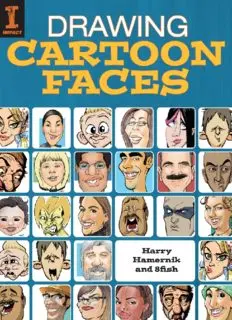
Drawing Cartoon Faces: 55+ Projects for Cartoons, Caricatures & Comic Portraits PDF
Preview Drawing Cartoon Faces: 55+ Projects for Cartoons, Caricatures & Comic Portraits
Drawing Cartoon Faces Harry Hamernik and 8fish Cincinnati, Ohio www.impact-books.com Thank you for purchasing this Artist Network eBook. Sign up for our newsletter and receive special offers, access to free content, and information on the latest new releases and must-have art resources! Plus, receive a coupon code to use on your first purchase from NorthLightShop.com for signing up. or visit us online to sign up at http://artistsnetwork.com/ebook-promo Contents Introduction 1 The Fundamentals Materials and Equipment Drawing and Sketching Inking and Shading Marker Techniques Pencil Techniques Colored Pencil Techniques Using the Pattern Technique Coloring a Face With Colored Pencils Computer Coloring The 4 Points of Expressions Creating Expressions The Head Drawing a Front View Distance, Anchor and Pivot Points Forming Face Shapes Drawing Noses Forming Eyes and Eyebrows Drawing Eyes Varying the Eyes Example Eyes Creating Mouths Drawing Hair Embellishing Ears Knowing Your Necks 2 Caricatures Using the Same Angle Drawing a Baby Simple Faces Working With Ponytails Hair With Texture Working With a Beard Drawing the Three-Quarters View Drawing Three-Quarters View Eyes Creating a Three-Quarters View Nose Forming a Three-Quarters View Mouth Designing Three-Quarters View Face Shapes Drawing Three-Quarters View Hair Using Facial Rhythm Lines Pulling the Face Together Capturing a Likeness Clothing and Decorative Lines Analyzing Face Shapes Using Pencils Like Markers Mastering Facial Hair Hair Covering the Face Color Enhances Ethnic Faces Working With a Dynamic Model Making Hair a Graphic Element Drawing Profile Caricatures Profile Facial Features Varying the Profile Line Drawing a Complex Profile Using Heavy Pencil Lines Drawing Long, Long Hair Full-Figured Subject 3 Scenarios & Characters Billy Finds a Flower Joyful Happy About to Sneeze Sad The Villain Conniving Angry Deep in Thought Stages of Fear Dread Laughter Terror Tuna for Lunch Annoyed Something Stinks Disgusted The Hobo Crazy Yummy! Drunk Hung Over Gina Gets a Lecture Dumbfounded Rolling Eyes Hostile Betsy the Farm Girl Pouty Sassy Flirty The Fight Ready for Action Growling Yelling Attacking Slugged in the Gut Electrocuted Exhausted Gloating Love Is in the Air Coy Shy Seductive 4 Storytelling Framing Body Language Single panel : Zombie & Cave Girl Single Panel: Space Man vs. Alien Monster Two panel: Shot/Reverse Shot Noir Interrogation Three panel: Establishing Shot and Close-ups Western Standoff Single Panel: Sectioned With Three Characters Mexican Standoff Single panel: Three Characters With Inset Damsel in Distress Cover: Splash Page Superhero Team Cover: Splash Page Supervillains Battle Scene Copyright Introduction Art and expression are commonly considered synonymous. This is especially easy to see in the world of comics and cartoons. The main purpose of a comic was to grab the reader’s attention with larger-than-life drama. The stories and characters were big and bold. Comics and cartoons have progressed into areas of sophistication and subtlety today, but they are still all about expression and telling a story. All comics have characters, and all characters have expressions. A compelling story is told with a range of emotions. The characters are more than just happy, sad or angry. They can be ecstatic, depressed or full of rage. If you truly want to create characters that are realistic, three-dimensional and engaging, you have to start delving into the infinite number of complex expressions we possess. Why? Because the human experience is deep. We’ll look at many different emotions to explore that human experience. Faces are made up of many shapes that change with each expression. Cartoons frequently take these main aspects of the face and exaggerate them to show more expression. Caricatures are a perfect example of exaggerated features. That’s what makes drawing them so much fun! You’ll learn how to focus in on the standout pieces of the face, such as the eyes, nose or lips. Then these lessons can be applied to explore various expressions. Practicing caricatures of real people will help stretch your imagination and ability to create new characters. By the end of the book, you’ll know how to draw cartoon faces, expressions and how to put it all together to create a story.
